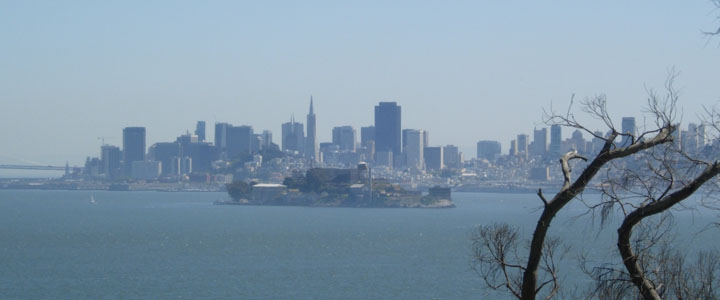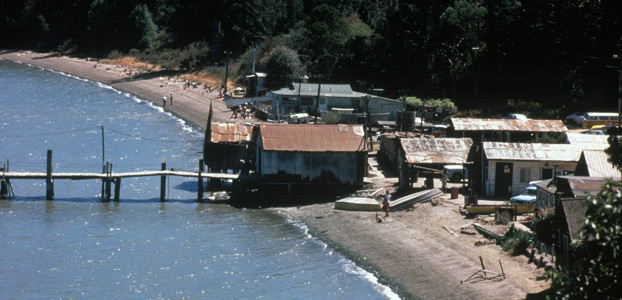As of press time, the future of California’s state parks remains in limbo. A modified version of Governor Arnold Schwarzenegger’s latest budget—which proposes eliminating all state funding for parks during the 2009-2010 and 2010-2011 fiscal years—is being readied for the state legislature’s vote.

This breathtaking view of the City skyline and Alcatraz Island could be off limits to the public if Angel Island State Park is closed by the State due to budget problems. Photo by Joel Williams
By Bill Picture
Published: July, 2009
As of press time, the future of California’s state parks remains in limbo. A modified version of Governor Arnold Schwarzenegger’s latest budget—which proposes eliminating all state funding for parks during the 2009-2010 and 2010-2011 fiscal years—is being readied for the state legislature’s vote. Without those state dollars or some alternate source of funding, most state parks will be forced to close or drastically scale back operations.
The California Department of Parks and Recreation has identified the parks that face possible closure—220 of California’s 278 state parks. Twenty-five of the parks on the Department’s list are located within an hour’s drive of San Francisco, including Angel Island State Park, Mount Tamalpais State Park, Samuel P. Taylor State Park, all of the beaches in San Mateo County, and Ano Nuevo State Natural Reserve, a major gathering area for northern elephant seals.
A New Proposal
On June 15, the state’s Budget Conference Committee signed off on the proposed cuts to state park funding, but also voted to support a plan for the creation of a new, dedicated funding source for parks. Under that plan, called the State Park Access Pass, owners of non-commercial vehicles would pay a $15 surcharge on top of their annual license fees. That $15 surcharge would allow all of the state parks to remain open, as well as provide Californians with free day-use access to the parks.
As of press time, it is uncertain whether the State Park Access Pass will be included in the final budget package presented to the state legislature by Schwarzenegger. The idea failed to gain the support of Republicans on the committee, so there’s a good chance that Schwarzenegger, who is anxious to get a budget approved before the fiscal year begins on July 1, could omit the State Park Access Pass to better the budget’s chance of getting the two-thirds vote needed from both houses.
“Knowing how bad of shape the state is in financially and how the political process works, I’m not as optimistic as some people,” says Matthews.
History at stake
Today a popular destination for day-trippers, Angel Island served as an immigrant processing and detention station from 1910 to 1940. During that time, more than one million newcomers, mostly immigrants from China, were detained here, earning the island the title “the Ellis Island of the West.”
In an effort to preserve that history, millions of state and federal dollars were recently used to renovate the former immigration station. The station was closed to the public in August 2005 and reopened in February of this year after a $15 million facelift. If state funding for parks is cut, and the State Park Access Pass is not enacted, public access to this important historical site, along with the rest of the island, would once again be shut off.
Though the issue has received a lot of media attention, Matthews says many visitors to the island are unaware of the possible closure. “Some know and are really upset about it, but others have no idea what’s going on,” he says. “When we tell them, they look at us like, ‘How are you going to close an island?’”
Thus far, the question of controlling access to closed, unstaffed parks has not been addressed. Erecting fences to keep people out could interfere with wildlife migration patterns, and would cost money that the state does not have. But, without some system in place to protect them, the parks face numerous potential risks.
“You can’t lock up a park like you lock the front door of your house or your car door,” explains Elizabeth Goldstein, president of the California Parks Foundation. “People will continue to use them unsupervised, and these are fragile natural environments.” Without staff around to make sure that visitors respect these pristine areas, Goldstein fears a likely increase in vandalism, homeless encampments, trash dumping and wildfires.
Last October, 400 of Angel Island State Park’s 740 acres were blackened in a fire believed to have been caused by humans. Thankfully, firefighters were able to save the island’s 120 historic structures. But Matthews believes that, had the island been unstaffed when the fire broke out, the outcome would have been much different. “I think we would have lost the entire island,” he says.
Park staff maintains the water systems on the island, and operates the watercraft used to ferry administrative and emergency vehicles to and from its shores. Without staff, firefighters would have had a tough time getting to the island. And, once they got there, there would have been no guarantee that the on-island water system would have been in good enough condition to fight such a large blaze.
Reopening the doors
Park advocates also fear that, if parks are indeed closed, readying them for visitors again in the future could prove to be prohibitively expensive such that some parks will remain closed permanently. “The restart costs would be steep,” says Matthews. “I’d compare it to closing up your winter home. When you open it back up, you can expect there to be damage.”
“Removing trash left behind, restoring trails that have eroded or grown over—that’s all going to cost money,” adds Goldstein. “I think we can be confident that making these places whole again is going to be expensive.”
Flawed math
According to parks advocates, the reasoning behind cutting off state funding to the parks is flawed. Schwarzenegger believes that doing so will save the state $143 million dollars. However, opponents of the plan say the state would be shooting itself in the foot, as parks generate millions of dollars of other taxable revenue that will be lost if parks are closed.
A recent study conducted by the California State University, Sacramento found that park visitors, on average, spend $57.63 per visit. That figures includes not only money spent in the parks, but also money spent at businesses in surrounding communities.
“These communities are extremely reliant on tourism,” explains Goldstein. “Places like Guerneville, Tiburon and Julian, a small community on the edge of the Anza-Borrego Desert State Park in Southern California, have an enormous amount of traffic coming through destined for state parks. And those people are spending money for parking, food and in local shops.”
Goldstein says that cutting off these small communities’ lifeblood would likely result in layoffs and, eventually, business closures, which could decimate local economies. “And, besides the money that visitors are spending, the state is also purchasing commodities and services in these communities,” adds Matthews. “So the numbers just aren’t adding up.”
“The ability of these small businesses to stay open is conditioned on the threshold of people coming to these parks,” Goldstein adds. “So for us to think that we’re saving money by closing the parks is incredibly naïve.”
In the case of Angel Island State Park, the park only costs $200,000 more to operate than it generates in on-site revenue. According to Goldstein, that $200,000 is a fraction of a percent of the state’s budget deficit, and hardly worth cutting off Bay Area residents’ access to this local treasure.
Saving the Future
That said, the parks appear to be at the mercy of legislators, who are expected to make a decision soon. In the meantime, parks advocates, including the California Parks Foundation, continue raising money to support the parks system and encouraging supporters to call on lawmakers in Sacramento to ensure Californians’ continued access to state parks. With the organization’s help, more than 115,000 letters have been sent to Schwarzenegger’s office by park lovers since the proposed budget’s announcement in late-May.
“This is by no means a done deal,” says Goldstein. “In fact, the question of whether there is the political will to support what is essentially a tax, albeit a very minor one, is up in the air at the moment. We’re very concerned, but hopeful.”
“The truth of the matter is, I don’t think we will be able to stop the park closures entirely,” she adds. “What we can do is minimize the closures so that we’re not decimating the system, but nothing will be totally saved.”
“We’re just waiting to see what happens,” says Matthews. “In the meantime, our job is to serve the public. We’re dedicated professionals, so we’ll just keep doing what we’re doing until we’re told otherwise.”
For more information on the California Parks Foundation, visit www.calparks.org

Samuel P. Taylor State Park in the steep rolling hills of Marin County 15 miles west of San Rafael is on the list of State Parks to be closed. Photo courtesy of California State Parks

China Camp State Park located on the shore of San Pablo Bay just east of San Rafael would also be closed under the new budget proposal. Photo courtesy of California State Parks

